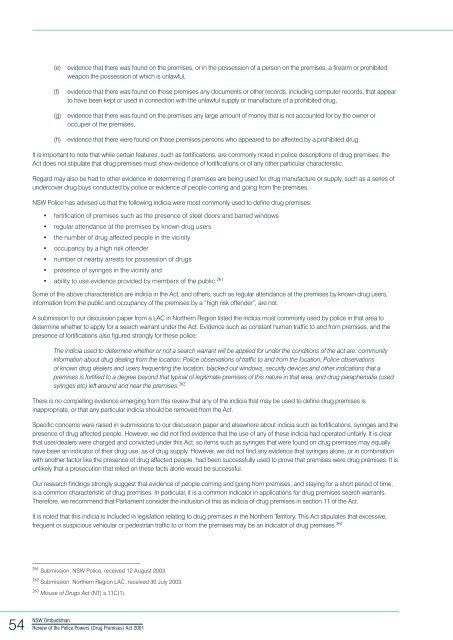Review of the Police Powers (Drug Premises) Act 2001 - NSW ...
Review of the Police Powers (Drug Premises) Act 2001 - NSW ...
Review of the Police Powers (Drug Premises) Act 2001 - NSW ...
You also want an ePaper? Increase the reach of your titles
YUMPU automatically turns print PDFs into web optimized ePapers that Google loves.
(e) evidence that <strong>the</strong>re was found on <strong>the</strong> premises, or in <strong>the</strong> possession <strong>of</strong> a person on <strong>the</strong> premises, a firearm or prohibited<br />
weapon <strong>the</strong> possession <strong>of</strong> which is unlawful,<br />
(f)<br />
evidence that <strong>the</strong>re was found on those premises any documents or o<strong>the</strong>r records, including computer records, that appear<br />
to have been kept or used in connection with <strong>the</strong> unlawful supply or manufacture <strong>of</strong> a prohibited drug,<br />
(g) evidence that <strong>the</strong>re was found on <strong>the</strong> premises any large amount <strong>of</strong> money that is not accounted for by <strong>the</strong> owner or<br />
occupier <strong>of</strong> <strong>the</strong> premises,<br />
(h) evidence that <strong>the</strong>re were found on those premises persons who appeared to be affected by a prohibited drug.<br />
It is important to note that while certain features, such as fortifications, are commonly noted in police descriptions <strong>of</strong> drug premises, <strong>the</strong><br />
<strong>Act</strong> does not stipulate that drug premises must show evidence <strong>of</strong> fortifications or <strong>of</strong> any o<strong>the</strong>r particular characteristic.<br />
Regard may also be had to o<strong>the</strong>r evidence in determining if premises are being used for drug manufacture or supply, such as a series <strong>of</strong><br />
undercover drug buys conducted by police or evidence <strong>of</strong> people coming and going from <strong>the</strong> premises.<br />
<strong>NSW</strong> <strong>Police</strong> has advised us that <strong>the</strong> following indicia were most commonly used to define drug premises:<br />
• fortification <strong>of</strong> premises such as <strong>the</strong> presence <strong>of</strong> steel doors and barred windows<br />
• regular attendance at <strong>the</strong> premises by known drug users<br />
• <strong>the</strong> number <strong>of</strong> drug affected people in <strong>the</strong> vicinity<br />
• occupancy by a high risk <strong>of</strong>fender<br />
• number <strong>of</strong> nearby arrests for possession <strong>of</strong> drugs<br />
• presence <strong>of</strong> syringes in <strong>the</strong> vicinity and<br />
• ability to use evidence provided by members <strong>of</strong> <strong>the</strong> public. 261<br />
Some <strong>of</strong> <strong>the</strong> above characteristics are indicia in <strong>the</strong> <strong>Act</strong>, and o<strong>the</strong>rs, such as regular attendance at <strong>the</strong> premises by known drug users,<br />
information from <strong>the</strong> public and occupancy <strong>of</strong> <strong>the</strong> premises by a “high risk <strong>of</strong>fender”, are not.<br />
A submission to our discussion paper from a LAC in Nor<strong>the</strong>rn Region listed <strong>the</strong> indicia most commonly used by police in that area to<br />
determine whe<strong>the</strong>r to apply for a search warrant under <strong>the</strong> <strong>Act</strong>. Evidence such as constant human traffic to and from premises, and <strong>the</strong><br />
presence <strong>of</strong> fortifications also figured strongly for <strong>the</strong>se police:<br />
The indicia used to determine whe<strong>the</strong>r or not a search warrant will be applied for under <strong>the</strong> conditions <strong>of</strong> <strong>the</strong> act are: community<br />
information about drug dealing from <strong>the</strong> location; <strong>Police</strong> observations <strong>of</strong> traffic to and from <strong>the</strong> location; <strong>Police</strong> observations<br />
<strong>of</strong> known drug dealers and users frequenting <strong>the</strong> location; blacked out windows, security devices and o<strong>the</strong>r indications that a<br />
premises is fortified to a degree beyond that typical <strong>of</strong> legitimate premises <strong>of</strong> this nature in that area; and drug paraphernalia (used<br />
syringes etc) left around and near <strong>the</strong> premises. 262<br />
There is no compelling evidence emerging from this review that any <strong>of</strong> <strong>the</strong> indicia that may be used to define drug premises is<br />
inappropriate, or that any particular indicia should be removed from <strong>the</strong> <strong>Act</strong>.<br />
Specific concerns were raised in submissions to our discussion paper and elsewhere about indicia such as fortifications, syringes and <strong>the</strong><br />
presence <strong>of</strong> drug affected people. However, we did not find evidence that <strong>the</strong> use <strong>of</strong> any <strong>of</strong> <strong>the</strong>se indicia had operated unfairly. It is clear<br />
that user/dealers were charged and convicted under this <strong>Act</strong>, so items such as syringes that were found on drug premises may equally<br />
have been an indicator <strong>of</strong> <strong>the</strong>ir drug use, as <strong>of</strong> drug supply. However, we did not find any evidence that syringes alone, or in combination<br />
with ano<strong>the</strong>r factor like <strong>the</strong> presence <strong>of</strong> drug affected people, had been successfully used to prove that premises were drug premises. It is<br />
unlikely that a prosecution that relied on <strong>the</strong>se facts alone would be successful.<br />
Our research findings strongly suggest that evidence <strong>of</strong> people coming and going from premises, and staying for a short period <strong>of</strong> time,<br />
is a common characteristic <strong>of</strong> drug premises. In particular, it is a common indicator in applications for drug premises search warrants.<br />
Therefore, we recommend that Parliament consider <strong>the</strong> inclusion <strong>of</strong> this as indicia <strong>of</strong> drug premises in section 11 <strong>of</strong> <strong>the</strong> <strong>Act</strong>.<br />
It is noted that this indicia is included in legislation relating to drug premises in <strong>the</strong> Nor<strong>the</strong>rn Territory. This <strong>Act</strong> stipulates that excessive,<br />
frequent or suspicious vehicular or pedestrian traffic to or from <strong>the</strong> premises may be an indicator <strong>of</strong> drug premises. 263<br />
261 Submission, <strong>NSW</strong> <strong>Police</strong>, received 12 August 2003.<br />
262 Submission, Nor<strong>the</strong>rn Region LAC, received 30 July 2003.<br />
263 Misuse <strong>of</strong> <strong>Drug</strong>s <strong>Act</strong> (NT) s.11C(1).<br />
54<br />
<strong>NSW</strong> Ombudsman<br />
<strong>Review</strong> <strong>of</strong> <strong>the</strong> <strong>Police</strong> <strong>Powers</strong> (<strong>Drug</strong> <strong>Premises</strong>) <strong>Act</strong> <strong>2001</strong>
















